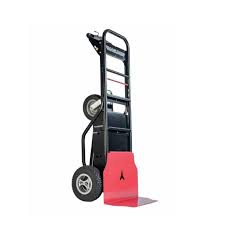Maintenance Procedures for Lasting Performance
Even the most resilient trolley or hand truck suffers from wear and tear with continuous use. Maintenance regime it is proactive, creates problems in small defects and not snow balling into break downs. Daily visual inspections catch castor threads filled with pallet wrap, decks bent out of shape from fork-arm impact, and wobbly loose fasteners before they affect performance. Grease nipples on kingpins and wheel bearings are also regularly lubricated every week — a practice that helps keep everything rolling smoothly and saves operator effort and energy. The regular checks of tyre inflation maintain damping and extends tread wear. A quick touch-up prevents corrosion from taking hold when decks start to show paint wear. Having a small inventory of wheel assemblies, axles and bearings on site makes repairs possible in minutes as opposed to waiting for supplier lead times. This tenacity maintains fleet availability, protects investment in procurement and strengthens a workplace culture that norms taking care of equipment.
Sustainable Selections of Trolley and Hand Truck
Increased expectations of corporate responsibility and regulatory frameworks are driving warehouses to adopt greener practices. Despite requiring electricity or fuel to operate, powered equipment is far more damaging to the environment than hand trolleys and hand trucks Melbourne, which require no energy apart from human power, producing zero direct emissions. That said, sustainability still factors into procurement calculus. Using locally manufactured units also helps to reduce embodied transport emissions and supports Australian industry. High-recycle-content steel or aluminium frame production closes material loops, while modifiable frames enable single-carbon-footprint/embodied-energy-modules to be replaced instead of an entire asset being retired. Powder-coat finishes are more durable than wet-spray paint, providing reduced volatile organic compound emissions over the years of ownership. Although the disposal of metal at end-of-life is unavoidable, scrap recycling recycles value returning better-performing product to the lifecycle. Conveying these green credentials to stakeholders can also improve brand and reputation and perhaps even attract government grants or certification points under green-building schemes.
Cost–Benefit Analysis: Getting the Most Bang for Your Buck
Yet, viewed in a nuanced way, trolleys and hand trucks too can be subjected to a financial evaluation—initial purchase prices are however small change compared to say automated systems. Total cost of ownership metrics like maintenance labour, replacement frequency and injury claims avoided, should never be sacrificed at the altar of upfront cost savings. One that lasts three years longer—all premium castors, save on parts budget and downtime. An ergonomic handle that prevents sprains could pay for itself in lower insurance excesses and fewer staff needing to be replaced. By analysing travel cycles it can be determined whether a model with greater volume can effectively reduce journeys by 50%, freeing labour capacity for revenue work. Decision-makers who factor in the above intangible savings with tangible purchase (o.e hardware, equipment) costs will find the economic case for quality equipment investing unquestionable.
Educating Your Workers on Proper Use
Not even the best trolley can provide what it promises if misused. Having structured on boarding mechanisms makes new hires aware of safe push techniques, load-cantering ideas and route etiquette. Single-occupancy steering emphasis, slow roll-ons and forth at intersections and clearly marking approaches to corners avoids collisions. Refresher sessions to remind to watch for overloading, which can take hold in peak season without people really even realizing it. Incorporating feedback about wheel performance, handle comfort and deck stability and channelling operator insight into ongoing improvement should be encouraged by supervisors. In environments with diverse language use, signage, and demonstration can go a long way to fostering understanding by providing a visual reference to unite everyone. When staff is confident in their equipment, and feel free to propose improvements, warehouse culture evolves from solving issues at the moment to a culture of excellence.
Integration of Trolleys and Hand Trucks with Warehouse Processes
Today, fulfilment centres leverage warehouse management systems, wearable scanners and pick-to-light technology to drive order flow. This digital fabric is woven into trolleys Melbourne and hand trucks. Tablets showing batch pick lists, using custom brackets, are secured to keep the information up front and centre and your hands free for the picking. Location tracking with built-in barcode plates, which are vital for real-time locating systems, empowers supervisors to identify congestion or non-operational assets on live dashboards. Solely focused on electric tracks, some facilities inject strips of induction charging along travel corridors; conductive castor paths meant to be an everlasting Wi-Fi charge to on-board devices at every pass of the trolley to get rid of the battery swap. Radio-frequency identification (RFID) readers with mount points for automated item confirmation as cartons are set on the deck save the scanning process. Instead of leading them to act like “analogue islands,” warehouses act intellectual nodes for manual equipment and turn them into data-generating tools to sharpen strategic decision-making.

